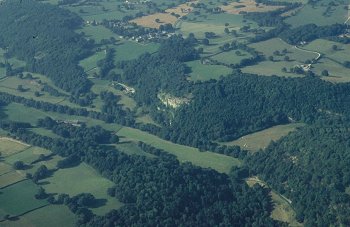
Cymraeg / English

|
Back Home |

|
Historic Landscapes |
Historic Landscape Characterisation
The Lower Elwy Valley
|
The following description, taken from the Historic Landscapes Register, identifies the essential historic landscape themes. This contained landscape is closely defined by the gorge of the River Elwy as it rounds Cefn Meiriadog, a low ridge on the eastern fringes of the Rhos Hills in north Denbighshire, and lying south west of St Asaph on the west side of the Vale of Clwyd. The valley’s narrow floor gently rises from about 30m above OD in the east to about 50m above OD in the west, while its densely wooded sides rise steeply or even precipitously in places as they cut through to the surrounding low hills and ridges which are between 100m and 150m above OD. The valley was probably formed by the glacial diversion of the River Elwy, possibly during the Middle Pleistocene period, before 250,000 years ago. Several sheer limestone cliffs occur along the north east side of the valley and the area around Cefn includes one of the most important groups of Palaeolithic and later caves and rock shelters in Britain, containing Quaternary geological and archaeological deposits of international significance. The caves include Pontnewydd, Cefn, Cae Gronw, Galltfaenan and Brasgyll. By the 1530s, the caves of the Elwy valley were already famous, being noted by the antiquary John Leland in his Itinerary of 1536–39, but their potential archaeological s i g n i ficance was not examined until 1830, when Cefn Old Cave was visited by the Reverend Edward Stanley (later Bishop of Norwich) who noted that ‘human as well as animal bones, together with stags’ horns, and, I believe, some remains of ancient weapons, have been found’. Stanley went on to investigate Cefn New Cave, making similar finds, and by the 1870s, Professor Boyd Dawkins, the eminent Vi c t o r i a n anthropologist and archaeologist, had reported the discoveries at both the Cefn caves, and at Pontnewydd, where investigations by Professor McKenny Hughes led to the recovery of animal and human remains and associated stone tools. It is the latter cave, at Pontnewydd, that has become famous recently for its finds of early Neanderthal remains, which represent the most north westerly known site of this date in Europe, some of the earliest human remains in the British Isles and the earliest known occupation in Wales. From the 1970s until the 1990s, excavations here, by the National Museum of Wales, have yielded a wide range of stone artefacts and animal bones and, most significantly, human teeth and bone fragments from several individuals, showing that this cave was used by humans about a quarter of a million years ago. The sequence of the cave deposits which contained this important and fascinating evidence was complex, but it appears that the cave was occupied at the end of a warmer period, or at the beginning of a succeeding cold phase during the Ice Age. The deposits have been scientifically dated to some time around 225,000 years ago. Subsequent advances and retreats of ice have substantially remodelled the valley’s topography, and the excavation results suggest that the position of the cliff face and cave mouth at the time of the occupation was some distance forward of their present position. This weathering back of the cliff face would have caused the removal of most of the evidence for the occupation of the site, particularly from around the cave mouth, but in any event it appears that the deposits found in the surviving part of the cave were washed in as mud flows which fortuitously carried in and preserved residual material derived from the occupation of the site. To the north of Pontnewydd cave are the remains of medieval field systems in the form of strip lynchets, which hint at the area’s medieval agricultural economy, and sheltered beneath a wooded slope just above the valley floor to the east, are the ruins of the medieval holy well and chapel at Ffynnon Fair which attest to contemporary religious life in the area. The valley today presents a landscape of coherent historic interest which, though small in comparison to other historic landscape areas identified in this Register, is remarkably complete, for as well as the highly important early archaeological evidence contained in the caves, the landforms themselves provide a key to the interpretation of the area’s long sedimentary history and tantalizing glimpses of the environment of the earliest known inhabitant of Wales. |
For further information please contact the Clwyd-Powys Archaeological Trust at this address, or link to the Countryside Council for Wales' web site at www.ccw.gov.uk.
Privacy and cookies
